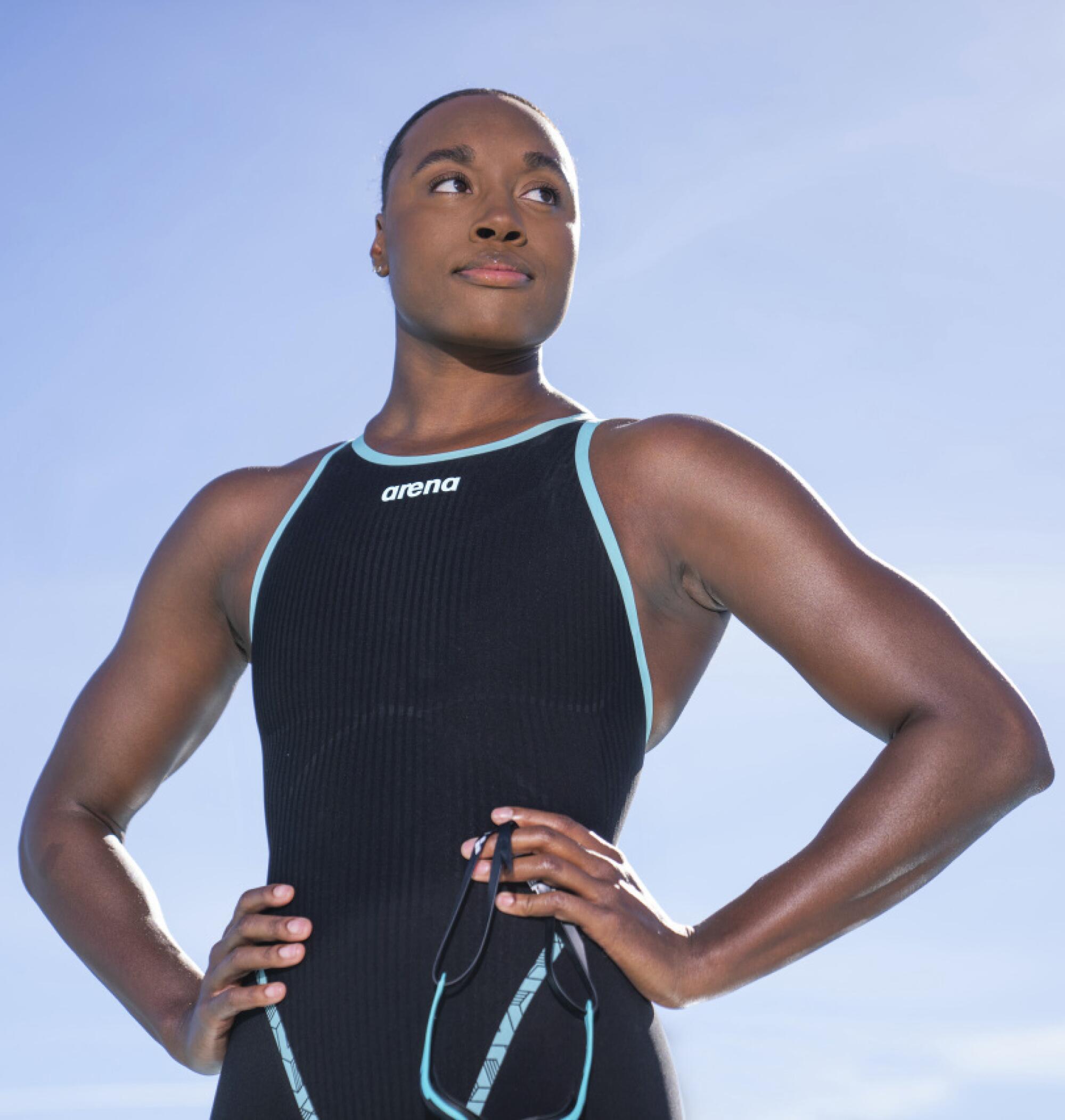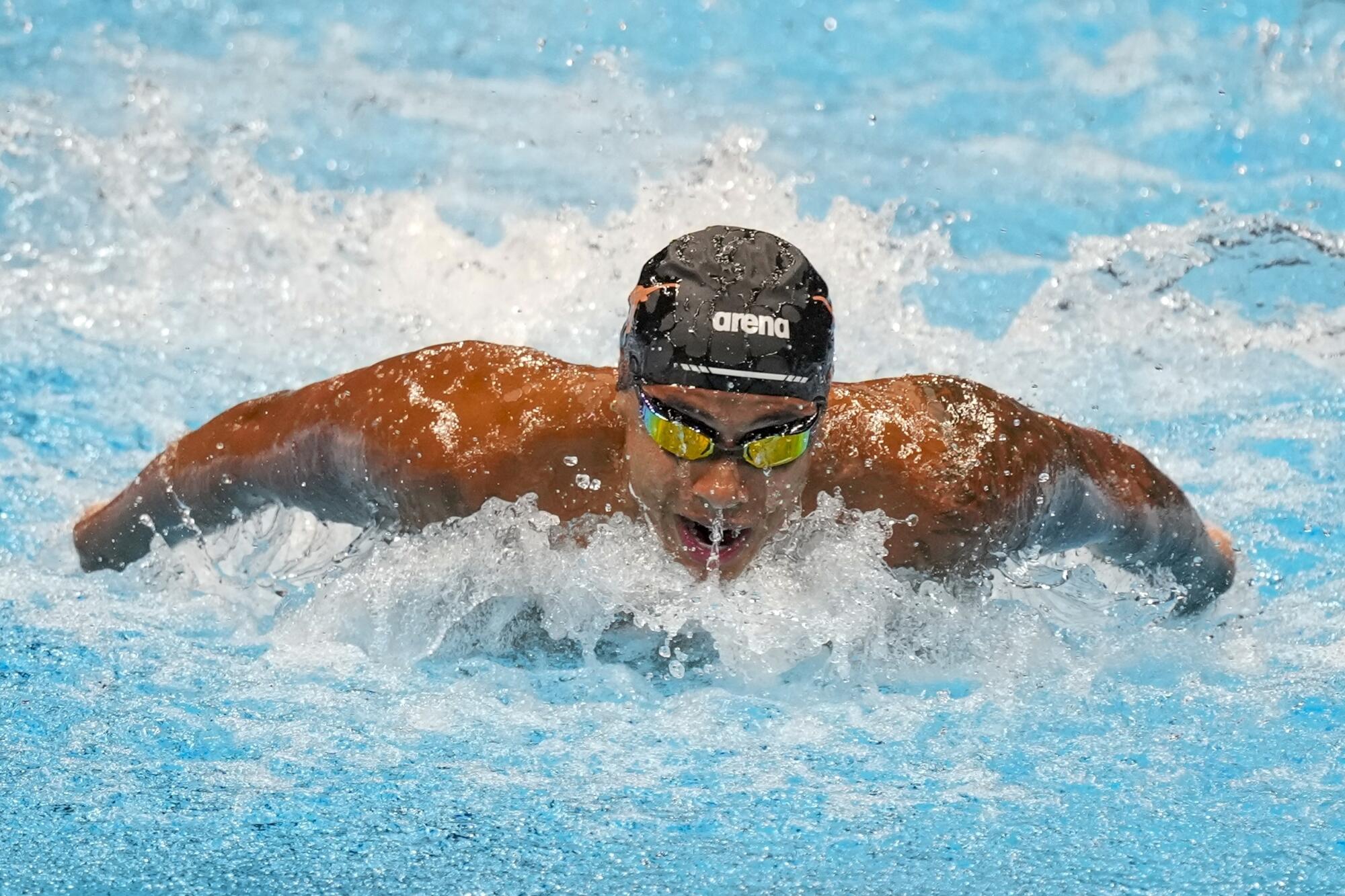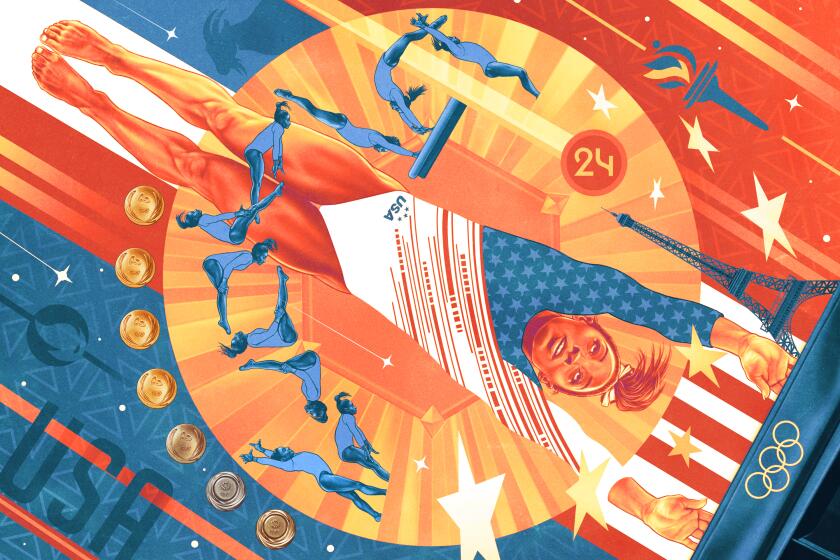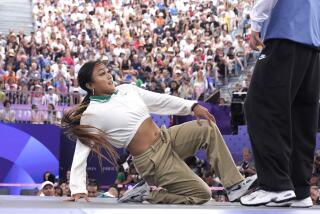
- Share via
PARIS — When Maritza Correia McClendon started swimming in Puerto Rico, she stood out because of her talent, not the color of her skin.
“There’s a lot of diversity in Puerto Rico,” said McClendon, who is Black and Latino, as are one in five people on the island.
Then her Guyanese-born parents moved to Florida when she was 8. Though she had become even faster in the pool, that was no longer the first thing people noticed about her.
“I remember a parent telling me, ‘What are you doing here? You should go do track or you should go on a basketball court,’” she said. “They were almost shaming me for being that outcast on that pool deck.
“That is definitely traumatizing. It’s still hard for me. I do definitely still struggle with that confidence factor.”
McClendon overcame that to become the first Puerto Rican of African descent to make the U.S. Olympic swimming team, the first Black female to win an Olympic medal for the U.S. and the first Black American swimmer to hold a world record.
In an effort to get others to follow her lead, McClendon is now among a growing number of former swimmers, coaches, officials and administrators working to make the sport more accessible and welcoming for people of color, from the grassroots level, where she was once shunned, to the Olympic team, where she shined.
The Paris Games has the opportunity to provide a big boost in those efforts when the swimming competition begins Saturday. Although only two of the 46 pool swimmers who will compete for the U.S. in Paris are Black — and none are Latino — those two, Shaine Casas, a three-time world champion, and Simone Manuel, a two-time Olympic champion and five-time Olympic medalist, have a chance to inspire a generation.
“If you’re not seeing somebody that you can relate to as a swimmer, then who’s going to be your role model?” said Steve Roush, executive director of Southern California Swimming, the grassroots affiliate of USA Swimming and the largest of the nation’s 59 local swim committees. “When you’ve seen over the last few years people like Simone Manuel, interests in the Black population say, ‘Hey, I guess we can swim. I guess there are spots for us.’ If they’ve never seen a Black on an Olympic or national team, then it’s really hard for them to think, ‘That’s what I want to do.’”
USA Swimming says less than 5% of the athletes registered with the federation are Black or Latino. Those groups account for 31% of the U.S. population. The level of representation on the Olympic team is no better. The reason for that has little to do with talent.

“It’s not an athletic thing,” said Nic Askew, coach of the swim team at Howard University, the only HBCU to compete in the sport. “Anyone of any race and culture can be an amazing athlete in anything. But when you look at the history and the neglect, it absolutely is more social and socioeconomic.”
Until the last half of the 20th century, Black people and Latinos were commonly prohibited from using public pools and beaches. When those bans were lifted, the lack of swim facilities in inner-city neighborhoods became a new impediment to the sport.
“It’s very, very expensive,” McClendon said. “Not only for the person to learn how to swim, but also for the community to keep a pool open. The cost of the water, the chemicals, lifeguards. Every part of it tends to be very expensive.
“That’s a big hurdle. Another one is generational trauma. When our parents were growing up in segregation, they weren’t even allowed to go to the pool. So there became a fear of going to the water.”
That lack of access has had consequences that stretch beyond making an Olympic team. According to a 2021 study conducted by the USA Swimming Foundation and the University of Memphis, more than two-thirds of Black children do not know how to swim. The number is 45% for Latino children. As a result, the Centers for Disease Control and Prevention found the rate of drowning deaths among Black children aged 10-14 is 7.6% higher than whites of the same age while the rate for Latinos rose 25% between 2019 and 2022.
“Swimming,” McClendon said, “is the only sport that is also a life-saving skill.”
Yet as long as children of color don’t see themselves represented there, they will continue to believe swimming is not for them. That makes the Olympics — and especially the presence of athletes such as Casas, Manuel and Cullen Jones, the first Black American swimmer to break a world record — so important.
Casas, 24, a former world champion in the backstroke, will swim the 200 individual medley in Paris. That event begins Aug. 1. Manuel, who turns 28 next week, will swim the 4x100 freestyle relay Saturday and the individual 50 freestyle next week. She won gold medals in the 100 freestyle and the relay in Rio de Janeiro in 2016 and won a relay bronze in Tokyo three years ago.

If both can repeat their success in France, it could provide a big boost to make swimming more diverse in the U.S.
Progress is being made on other fronts as well. In Paris another barrier will fall — and another example will be created — when Anthony Nesty, a former gold medalist for Suriname and the coach at the University of Florida, becomes the first Black head coach of a U.S. Olympic men’s swim team. At the grassroots level, Roush said nearly a fifth of Southern California Swimming’s 20,000 athletes are Latino, a record for the region.
“The participation’s there,” he said. “I think we are reflective of the diverse ethnicity within Southern California. But these numbers aren’t reflective of what’s out there on the national scene.”
Making those numbers reflective of the population at large is important for a number of reasons, said Richard Lapchick, president of the Institute for Diversity and Ethics in Sport at the University of Central Florida.
Tennis, for example, shed its country club image when Serena and Venus Williams began to dominate the sport. That has not only brought more fans and more revenue to the sport, it has brought more and diverse participants as well, with the number of people playing the sport in the U.S. increasing by 33% between 2020 and 2023.
Not surprisingly that growth was most dramatic among people of color with the number of Latino players growing by 90% over that three-year period while Black participation increased by 46%.
The Yurchenko double pike has become Simone Biles’ signature move in the vault, a gravity-defying, six-second burst that has added to her legend.
“In any area, if you’re not raising a population that is representative of the entire country, you’re excluding [many] that could have been [great],” Lapchick said.
“Part of the reason why it would be helpful if [swimming] was more diverse, there are people who won’t pay attention to swimming because they look at it as a sport that’s exclusive rather than inclusive.”
Without the Williams sisters, we might never have gotten Coco Gauff. And without Black Olympic gymnastics champion Gabby Douglas, we might never have gotten Simone Biles. Over the next nine days, Casas and Manuel have a chance to do the same for Black and Latino swimmers. That opportunity is a fleeting one that only comes around once every four years.
“The one time historically that swimming is at the top of the media or a topic of conversation is during the Olympics,” Askew said. “But the Olympic cycle is every four years. So to be able to see athletes like Shaine and Simone now, it’s phenomenal.
“This is a space that a Black person can be at this elite level.”
More to Read
Go beyond the scoreboard
Get the latest on L.A.'s teams in the daily Sports Report newsletter.
You may occasionally receive promotional content from the Los Angeles Times.








